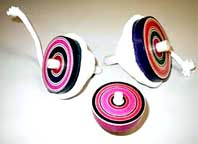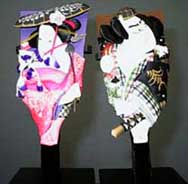 Japan has many traditional toys and games that
have kept children amused since the middle ages. Although modern life
is hectic, and kids don't have as much time to play as they did in bygone
days, some of these old-fashioned toys and games are as popular as ever.
Nowadays, many of them make their appearance mainly around the New Year
holidays.
Japan has many traditional toys and games that
have kept children amused since the middle ages. Although modern life
is hectic, and kids don't have as much time to play as they did in bygone
days, some of these old-fashioned toys and games are as popular as ever.
Nowadays, many of them make their appearance mainly around the New Year
holidays.
One example is a game called menko, which
involves throwing circular or rectangular playing cards on the ground.
 You try to flip your opponent's card over by throwing your card on top
of it. Menko has been around since the 1700s. The game cards
are often decorated with pictures of comic-book heroes, baseball players,
actors, and other popular celebrities. Menko is popular mostly
among boys.
You try to flip your opponent's card over by throwing your card on top
of it. Menko has been around since the 1700s. The game cards
are often decorated with pictures of comic-book heroes, baseball players,
actors, and other popular celebrities. Menko is popular mostly
among boys.
Japanese boys also like playing with tops and
kites. Tops, or koma, spun either by hand or with a string, came
to Japan about a thousand years ago from China. During the Edo period
(1603-1868), a competitive game with tops became popular.  Using
a string, players spun small wooden or steel tops called bei-goma
inside a ring, usually a bucket covered with a towel, and tried to knock
their opponents' tops out of bounds.
Using
a string, players spun small wooden or steel tops called bei-goma
inside a ring, usually a bucket covered with a towel, and tried to knock
their opponents' tops out of bounds.  Over
the years, many different kinds of tops have been created in Japan,
including tops that make noise and tops that spin extra fast.
Over
the years, many different kinds of tops have been created in Japan,
including tops that make noise and tops that spin extra fast.
Another traditional Japanese toy, the kite,
or tako, is loved particularly by boys throughout the country
and have a special place in their hearts.  Kites
came to Japan from China in the Heian period (794-1185), and were wildly
popular during the Edo period. They come in a variety of shapes, including square and
hexagonal, and are often decorated with traditional pictures
and patterns. One kind of kite popular among merchant families in the
old days was known as a yakkodako. These kites were made to resemble
human figures with their arms outstretched in comical poses. Merchants
had the kites made in the likeness of their servants. Kite-flying was
a major pastime in bygone days. Communities launched enormous kites,
sometimes over a hundred square meters (about 1,090 square feet) in
size. Kite wars, in which players tried to sever their opponents' kite
strings, were also popular.
Kites
came to Japan from China in the Heian period (794-1185), and were wildly
popular during the Edo period. They come in a variety of shapes, including square and
hexagonal, and are often decorated with traditional pictures
and patterns. One kind of kite popular among merchant families in the
old days was known as a yakkodako. These kites were made to resemble
human figures with their arms outstretched in comical poses. Merchants
had the kites made in the likeness of their servants. Kite-flying was
a major pastime in bygone days. Communities launched enormous kites,
sometimes over a hundred square meters (about 1,090 square feet) in
size. Kite wars, in which players tried to sever their opponents' kite
strings, were also popular.
 Japanese
girls have their own favorite traditional toys and games. One popular
game that has been around for a long time is hanetsuki, which
resembles badminton but uses no net.
Japanese
girls have their own favorite traditional toys and games. One popular
game that has been around for a long time is hanetsuki, which
resembles badminton but uses no net.  The
shuttlecock is made from a seed with feathers attached, and the paddle,
called a hagoita, is rectangular and made of wood. Hanetsuki
dates back over 500 years. The paddles are decorated with various images,
sometimes executed in relief: girls in kimonos, Kabuki actors, and so
on. While kids still like to play hanetsuki, many people simply
enjoy collecting the paddles for their decorative value.
The
shuttlecock is made from a seed with feathers attached, and the paddle,
called a hagoita, is rectangular and made of wood. Hanetsuki
dates back over 500 years. The paddles are decorated with various images,
sometimes executed in relief: girls in kimonos, Kabuki actors, and so
on. While kids still like to play hanetsuki, many people simply
enjoy collecting the paddles for their decorative value.
Japanese children also enjoy playing cards known
as karuta. Karuta are rectangular like Western playing cards, but instead
of numbers and figures, they have pictures, words, and even poems on
them. There are several dozen cards in each set of karuta.

In one popular children's version of the game, known as iroha karuta,
the person designated as the "reader" has one set of cards with sayings
written on them, while the other players gather around a spread-out
set of cards with the first letter or few words of the saying and a
picture on them. When the reader starts reading a saying, the players
try to find the matching card from those spead out in front of them.
Whoever finds the card first wins the round and collects the card. The
player with the most cards at the end wins. Iroha karuta has been around
since the Edo period, and the messages on the cards are popular sayings
that often come up in everyday life.
 Japan has many traditional toys and games that
have kept children amused since the middle ages. Although modern life
is hectic, and kids don't have as much time to play as they did in bygone
days, some of these old-fashioned toys and games are as popular as ever.
Nowadays, many of them make their appearance mainly around the New Year
holidays.
Japan has many traditional toys and games that
have kept children amused since the middle ages. Although modern life
is hectic, and kids don't have as much time to play as they did in bygone
days, some of these old-fashioned toys and games are as popular as ever.
Nowadays, many of them make their appearance mainly around the New Year
holidays. You try to flip your opponent's card over by throwing your card on top
of it. Menko has been around since the 1700s. The game cards
are often decorated with pictures of comic-book heroes, baseball players,
actors, and other popular celebrities. Menko is popular mostly
among boys.
You try to flip your opponent's card over by throwing your card on top
of it. Menko has been around since the 1700s. The game cards
are often decorated with pictures of comic-book heroes, baseball players,
actors, and other popular celebrities. Menko is popular mostly
among boys.
 Using
a string, players spun small wooden or steel tops called bei-goma
inside a ring, usually a bucket covered with a towel, and tried to knock
their opponents' tops out of bounds.
Using
a string, players spun small wooden or steel tops called bei-goma
inside a ring, usually a bucket covered with a towel, and tried to knock
their opponents' tops out of bounds.  Over
the years, many different kinds of tops have been created in Japan,
including tops that make noise and tops that spin extra fast.
Over
the years, many different kinds of tops have been created in Japan,
including tops that make noise and tops that spin extra fast. Kites
came to Japan from China in the Heian period (794-1185), and were wildly
popular during the Edo period. They come in a variety of shapes, including square and
hexagonal, and are often decorated with traditional pictures
and patterns. One kind of kite popular among merchant families in the
old days was known as a yakkodako. These kites were made to resemble
human figures with their arms outstretched in comical poses. Merchants
had the kites made in the likeness of their servants. Kite-flying was
a major pastime in bygone days. Communities launched enormous kites,
sometimes over a hundred square meters (about 1,090 square feet) in
size. Kite wars, in which players tried to sever their opponents' kite
strings, were also popular.
Kites
came to Japan from China in the Heian period (794-1185), and were wildly
popular during the Edo period. They come in a variety of shapes, including square and
hexagonal, and are often decorated with traditional pictures
and patterns. One kind of kite popular among merchant families in the
old days was known as a yakkodako. These kites were made to resemble
human figures with their arms outstretched in comical poses. Merchants
had the kites made in the likeness of their servants. Kite-flying was
a major pastime in bygone days. Communities launched enormous kites,
sometimes over a hundred square meters (about 1,090 square feet) in
size. Kite wars, in which players tried to sever their opponents' kite
strings, were also popular. Japanese
girls have their own favorite traditional toys and games. One popular
game that has been around for a long time is hanetsuki, which
resembles badminton but uses no net.
Japanese
girls have their own favorite traditional toys and games. One popular
game that has been around for a long time is hanetsuki, which
resembles badminton but uses no net.  The
shuttlecock is made from a seed with feathers attached, and the paddle,
called a hagoita, is rectangular and made of wood. Hanetsuki
dates back over 500 years. The paddles are decorated with various images,
sometimes executed in relief: girls in kimonos, Kabuki actors, and so
on. While kids still like to play hanetsuki, many people simply
enjoy collecting the paddles for their decorative value.
The
shuttlecock is made from a seed with feathers attached, and the paddle,
called a hagoita, is rectangular and made of wood. Hanetsuki
dates back over 500 years. The paddles are decorated with various images,
sometimes executed in relief: girls in kimonos, Kabuki actors, and so
on. While kids still like to play hanetsuki, many people simply
enjoy collecting the paddles for their decorative value. 